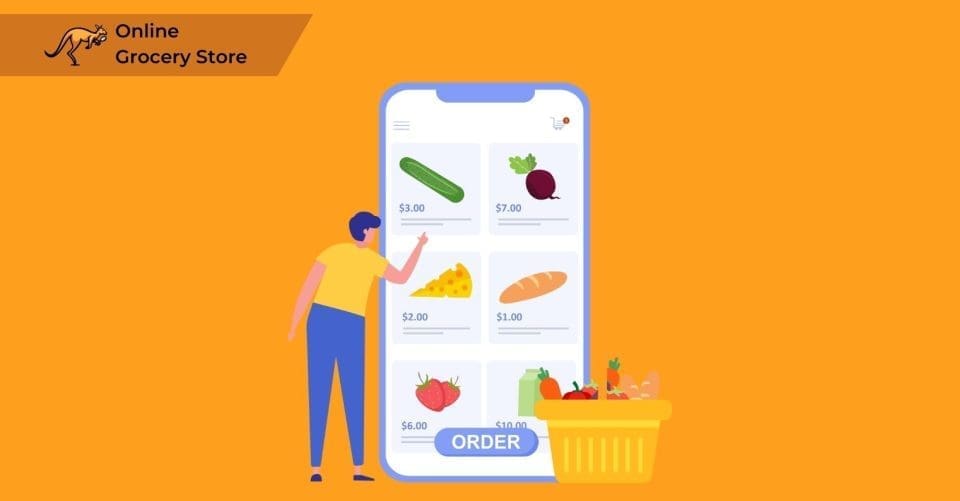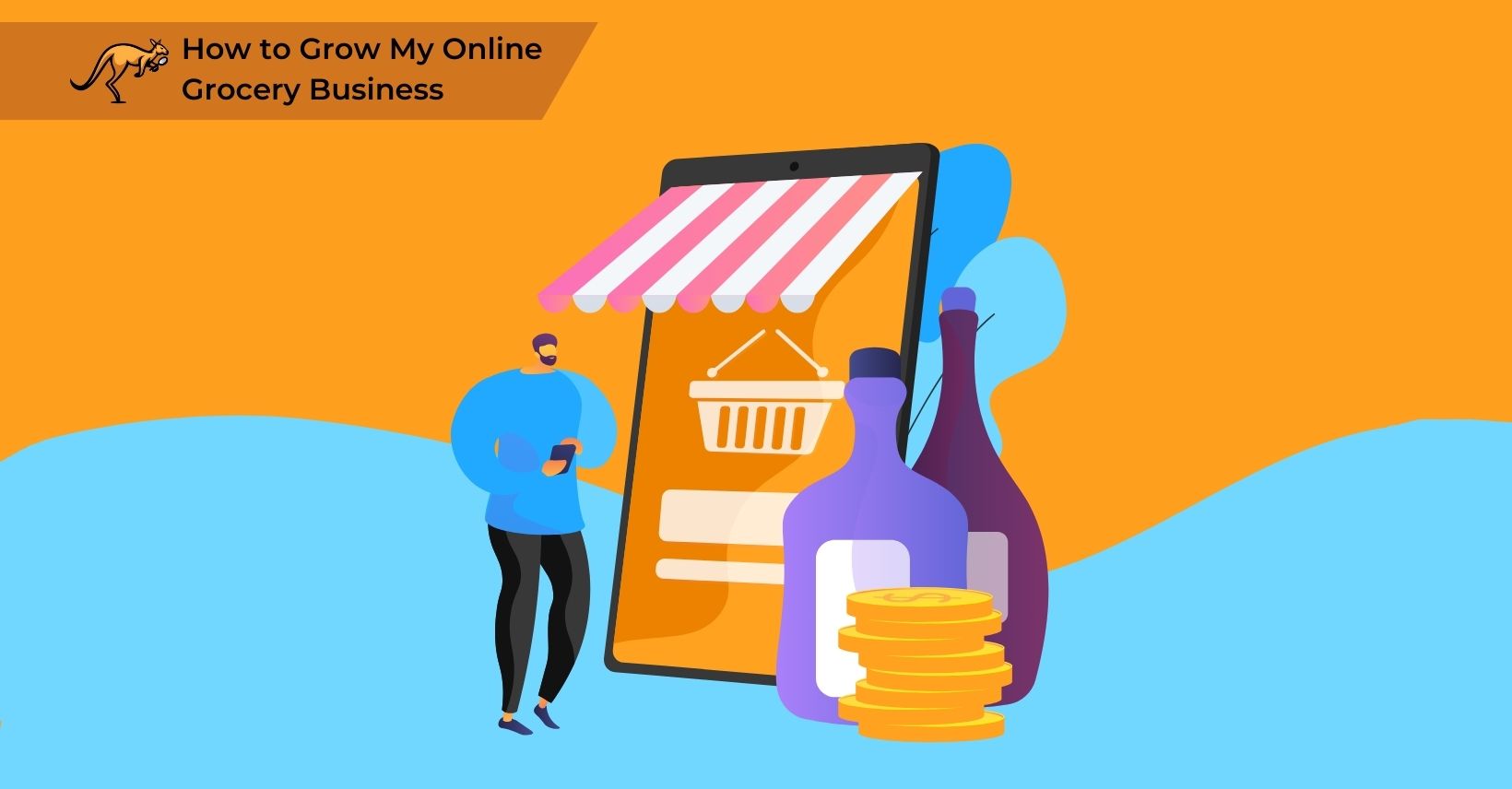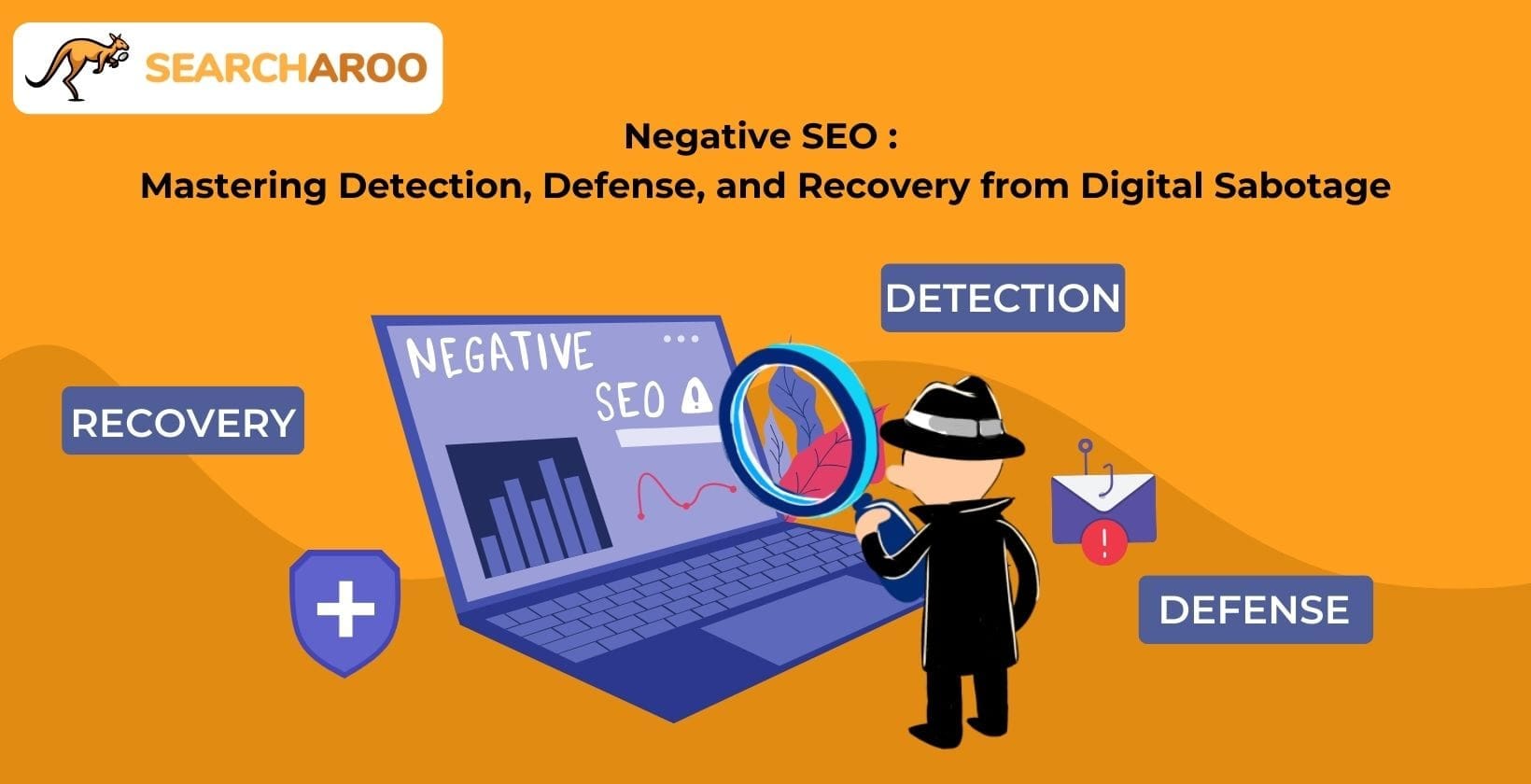Online grocery shopping is rapidly growing as many people prefer the convenience of delivery to their door.
Modern consumers seek ease, and grocery delivery meets this need perfectly. The global pandemic and technological growth have drastically changed shopping habits.
People now expect quick, simple shopping that doesn’t compromise safety or comfort.
An online grocery store fulfils this need effectively, making it a great time to start such a business. Offering essential products like groceries in a large market makes sense.
In this guide, we’ll explore how to grow your online grocery business and key considerations for success. Speaking of online grocery stores, what exactly are they?
What Is An Online Grocery Store?

E-commerce is booming, and online grocery stores are part of this trend. Online grocery stores function as digital platforms where customers browse, select, and pay for grocery items through websites or mobile apps, which then process orders for home delivery or pickup. Shoppers can order from home, and groceries are conveniently delivered to their doorstep within scheduled timeframes.
Online shopping offers many benefits, and its popularity has soared. Both local and large grocery businesses can create online stores to reach more customers. Not being online means missing out on significant profits, as more people shop online, including for groceries.
Creating an online grocery store offers convenience and can boost your business’s success. However, to make the most of this opportunity, there are important factors to consider
Starting an online grocery business requires selecting a suitable business model, securing reliable suppliers, developing a user-friendly website or app, establishing efficient delivery systems, and implementing effective marketing strategies. Online grocery businesses begin with thorough market research to identify target customers and their shopping preferences, which guides all subsequent business decisions.
Things To Consider Before Creating An Online Grocery Store

Before starting an online grocery store, several factors must be considered to ensure a successful venture in grocery delivery. With the rise in online shopping, entering the online grocery retail market can be lucrative. However, careful planning is essential. Key considerations include:
- Assess your current grocery business model or create one tailored for online shopping.
- Understanding your target market and how current events may influence their needs.
- Managing the transformation from a traditional grocery store to a grocery eCommerce platform.
- Defining your delivery regions and segmenting them effectively.
- Conducting competitor analysis and market research.
- Exploring other eCommerce options like mobile shopping and mobile apps.
A comprehensive plan addressing these aspects is crucial for the success of your online grocery business. Creating a business plan for an online grocery store includes defining your value proposition, analyzing market opportunities, outlining operational procedures, developing financial projections, and establishing growth milestones. Online grocery business plans should detail inventory management systems, delivery logistics, technology requirements, staffing needs, and marketing strategies that will differentiate your service from competitors.
As we explore the strategies to ensure success, we will also examine the various business models for online grocery shopping.
Types of Online Grocery Shopping Business Models
Let’s examine online stores’ different business model stores and consider how they might fit your grocery business. Choosing the right model makes setting up an online grocery store easier and more appealing to customers.
Hyperlocal Business Model
This model suits local grocery stores that aim to deliver rapidly within a specific area. With hyperlocal delivery, consumers get fresh produce and groceries on the same day, sourced from micro fulfilment centres to ensure speed.
Local stores maintain customer loyalty by covering basic needs and offering quick door-to-door service. This mobile-friendly model involves three tiers: local grocery stores (possibly multiple vendors), in-store shoppers, and delivery services.
Home-based online grocery businesses typically start with the hyperlocal model, which allows entrepreneurs to operate without large warehouses by partnering with local suppliers or stores. Home-based grocery operations focus on curated selections, specialty products, or niche markets that require minimal storage space, which makes them manageable from residential settings with proper food safety protocols.
Inventory Business Model
This model provides fresh groceries from various vendors with door-to-door delivery, like FreshDirect. Good inventory management ensures fresh groceries are always available and sourced from local vendors. Local stores and supermarkets can offer various products, keeping produce fresh through refrigerated vans and efficient route planning.
Transitioning from inventory management, it’s worth exploring how a multi-vendor business model can offer even more options and flexibility.
Multi-vendor business model
A grocery website can provide online shoppers with items from various vendors, not just one store. The grocery industry is vast, with many companies offering products that customers need daily.
Some brands, like Peapod, initially offered a range of grocery brands from their warehouses. As the online marketplace has grown, they now connect with other grocery businesses to enhance their service.
By collaborating with other online grocery businesses in a multi-vendor business model, you can retain existing customers and attract shoppers from other vendors.
As the core of this model, the delivery service must be maintained to a high standard to keep customers loyal and avoid them going directly to other online grocers. Improving our delivery service keeps customers and boosts our Google ranking, increasing our visibility and competitiveness.
Omnichannel business model
Major grocery stores like Walmart use an omnichannel business model where customer data is shared across channels. This model allows customers to engage with the company in the way that suits them best, whether through an online grocery store, mobile app, or traditional in-store experience. Sharing customer data across these channels ensures a seamless experience from in-store shopping to online.
With the right technology, a smooth transition is possible between in-store shopping, website orders, mobile app delivery services, inventory management, customer service, and distribution management. This seamless integration is essential for maximizing customer satisfaction and loyalty.
Maintaining high standards in delivery and ensuring seamless transitions across channels are crucial for an online grocery business. But what strategies can you use to turn this into a profit?
How To Make Money As An Online Grocery Business
Consider the revenue channels you want to activate for your online grocery business. Grocery delivery services can make money in various ways, including:
Commission per transaction
Businesses can charge a commission for every transaction done in online grocery sales. Online sales themselves bring in revenue, similar to in-store sales. However, to ensure going online is profitable, something extra is needed.
The commission per transaction is common in the e-commerce grocery industry. It can make online grocery stores more profitable over time. Consulting leads can provide valuable insights into optimizing commission structures for e-commerce grocery platforms.
Vendor subscription
If you work with multiple grocery retailers on your site, revenue can come from charging a subscription fee. Online grocery retailers periodically pay the online business a set fee to remain on the e-commerce platform.
A successful subscription service should offer several options or tiers to appeal to grocery retailers, allowing them to choose the best payment plan based on their business needs. The ability to upgrade or downgrade the subscription gives retailers more control. It determines their involvement in the e-commerce business.
Commission on delivery
Delivery services are a key revenue area for online grocery stores. Most online grocery businesses rely heavily on delivery services, so a significant portion of revenue comes from here.
E-commerce businesses often profit from delivery services by charging a commission for each delivery. Customers may pay separate fees from the grocery store plus a charge from the delivery service itself.
Effective revenue channels set the foundation, but exploring additional income streams can further boost profitability.
Secondary Revenue Streams
- On-site promotion for merchants, grocery items, and grocery delivery
- Hosting ads, such as banner ads
- Sponsored content that can be published on the website or relevant blog
- Sell customer data to market research firms.
- Ensure there is a good range of products available with branding to improve brand image and awareness (i.e., reusable shopping bags)
These strategies will set the foundation, but how can you draw more consumers to your online grocery store?
How To Entice Consumers To Your Online Grocery Store
The online grocery market is vast and intensely competitive. While more people buy groceries online, they have many options, so your brand must stand out.
Offering features and services that make shopping easier and more appealing can help you attract customers. Proper website management is essential for your online grocery store to ensure success.
Your website should function as smoothly as a traditional store, providing customers with ongoing support and the best shopping experience possible.
To attract new customers and achieve success with your online grocery business, focus on managing these areas:
Shop Management
Like a physical storefront, an online store needs proper management to provide the best customer experience. Your online storefront represents your brand to new customers, so effective shop management is crucial.
It allows authorized members to make necessary updates and changes, including altering available items, delivery slots, operational hours, packing time, and commission charges.
Order Management
Order management is where the grocery shopping happens. The order process must be easy and convenient to attract and retain customers. High levels of order management require features for all aspects of the ordering process, allowing vendors to manage multiple orders simultaneously.
Vendors should be able to see pending orders, total orders delivered, and order history. This data helps determine business success and provides feedback for improving the shopping experience.
Product Management
While convenience draws customers to online shopping, maintaining a well-stocked site keeps them returning. Online grocery stores should aim to offer the same or better service than physical shops.
Product management is essential for any successful e-commerce business, especially grocery stores. It should allow vendors to add and remove products based on availability, accurately represent available items, and update product information to keep customers informed.
Keeping a well-managed inventory ensures the smooth operation of these features.
Inventory management
Like product management, inventory management focuses on your store’s offers and availability. Inventory management for online grocery businesses requires automated systems that track stock levels in real-time, monitor product expiration dates, and trigger reordering when supplies run low.
Keeping inventory up-to-date after each customer selection can be challenging without a standardized or automated system. Effective grocery inventory systems integrate with point-of-sale software to automatically adjust stock levels after purchases, generate alerts for low-stock items, and provide analytics on product turnover rates to optimize purchasing decisions.
Tracking reports
This feature, provided by almost any development company, makes tracking sales, inventory, and consumer relations effortless. Online businesses strive for simplicity, which benefits both the business owner and customers. Daily sales reports, earning reports, and other essential data help gauge your brand’s success.
Delivery management platform
An online grocery store also functions as a delivery service, bringing groceries to customers’ doors. Delivery management for online grocery businesses requires route optimization software that minimizes delivery times, real-time tracking systems that keep customers informed, and temperature-controlled transport options that maintain food safety. A comprehensive delivery management platform combines GPS tracking of delivery personnel, automated customer notifications, delivery time windows, and performance analytics that measure on-time delivery rates and customer satisfaction scores.
Focusing on these aspects creates a robust system that enhances overall efficiency. Now, to take things one step further.
Once you’ve set up the basics for your grocery website, it’s time to explore additional features to enhance the shopping experience and gain accurate insights. Once your website is established, these enhancements can significantly contribute to your brand’s success.
Consider the following additions to elevate your brand:
- Multi-lingual Support: Make your site accessible to everyone by supporting multiple languages, allowing customers from different regions to shop in their preferred language.
- Multicart Options: For sites with multiple vendors, this feature lets customers add items from various stores into one order, offering a seamless shopping experience.
- Multiple Payment Options: Expand beyond traditional payment methods to include e-wallets and online transactions. You might also consider offering payment plans to help customers manage their grocery expenses.
- Delivery Schedule: Customers can choose convenient delivery time slots or store pickup. This flexibility can greatly improve customer satisfaction.
- Mobile App: Develop a dedicated mobile app for your services, enabling customers to order groceries on the go. Encourage app usage with promotions, like discounts for first-time users.
- Product Search and Filtering: Implement advanced search functionality with filters for dietary preferences, price ranges, brands, and product categories that help customers quickly find specific items.
- Recipe Integration: Add features that suggest recipes based on selected ingredients or allow customers to add all ingredients from a recipe to their cart with one click.
These enhancements can take your online grocery business to new heights. However, ensuring a robust online presence might require expert assistance in specific areas.
Is Hiring a Link-Building Agency Right for Your Online Grocery Business?
Hiring a link-building agency can boost your online grocery business. Link building increases website authority, improves search engine rankings, and drives organic traffic.
High-quality backlinks from reputable sources enhance site credibility, leading to better visibility and customer trust. Improved search rankings mean more consumers discover your store, increasing traffic and potential sales.
Professional link-building agencies identify and target the best sites for backlinks, ensuring effective marketing. This expertise saves you time and resources, allowing you to focus on other essential business aspects.
Partnering with Searcharoo can further enhance your business growth by offering tailored strategies and dedicated support.
Why Partner with Searcharoo to Grow Your Online Grocery Business?
Partnering with Searcharoo provides a distinct advantage for your online grocery business. Searcharoo, an industry leader in link-building and SEO services, offers extensive experience and a proven track record.
Our experts use data-driven strategies to secure high-quality backlinks, optimize your site for search engines, and boost your online presence.
We focus on meeting your business needs, providing customized plans that drive growth and profitability.
Leveraging our expertise enhances your website’s authority, attracts more organic traffic, and increases sales. Trusting Searcharoo lets you focus on serving your customers while we manage SEO and link building.
Concluding Insights on Online Grocery Store Success
Online grocery shopping is popular for customers nowadays as it offers safety and convenience. Following the pandemic, customers have grown more accustomed to having their items delivered to their door or collected at a time that suits their schedule.
E-commerce has increased in popularity significantly in the past few years alone, so now is a great time to get involved. An online grocery business can be profitable when managed correctly and meets customers’ needs.
In this guide, we have shared some of the best ways to ensure you have a successful online business that continues to grow alongside consumer demand. Meeting your customers’ basic needs is only the first step, as there is much more that your website can offer to grow your brand.
Grocery shopping is made easier with e-commerce platforms, and more people than ever before are shopping online. You can fit their needs and fill this gap in the market by creating a great website for your online grocery business.





